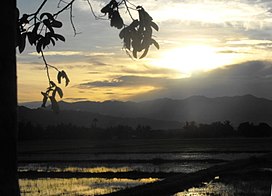| Allah Valley | |
|---|---|
 Allah Valley at Surallah, South Cotabato | |
| Area | 2,520 km2 (970 sq mi) |
| Geography | |
| Location | Mindanao |
| Country | Philippines |
| State | |
| Region | Soccsksargen |
| Population centers | |
| Borders on |
|
| Coordinates | 6°25′N124°42′E / 6.417°N 124.700°E |
| Rivers |
|
| Source: area [1] | |
The Allah Valley (at times also spelled Alah) is a large valley of the Allah River in the provinces of South Cotabato and Sultan Kudarat on the island of Mindanao, Philippines. It is formed by the Roxas-Matulas Range in the north and the Daguma Mountain Range in the south. [1]
Contents
It is accessible via the Allah Valley Airport in Surallah, South Cotabato. [2]
The valley is known for its natural environment, such as Lake Sebu, Lake Holon, Baras Bird Sanctuary, and Esperanza Hot and Cold Springs. [3] On the other hand, it is adversely affected by flooding, siltation, riverbank migration, unstable agriculture production, and upland degradation, [1] as well as illegal logging. [4]
The entire valley was declared a watershed forest reserve in 1985 through the signing of Proclamation No. 2455. The 102,350-hectare (252,900-acre) protected area also includes Lake Sebu, the Tasaday-Manobo Special Forest Reserve, the Datu Ma Falen Civil Reservation, and the National Cultural Minorities Settlement Reservation located within the valley. [5]
The bestselling Lonely Planet described Lake Sebu as a place located in a “bowl of forests and mountains.” The 42,450-hectare landscape consisting the domains of the Allah Valley is recognized by United Nations Educational, Scientific and Cultural Organization (UNESCO) as a cultural landscape in Mindanao. [6]

